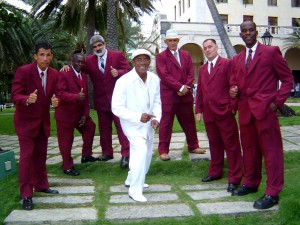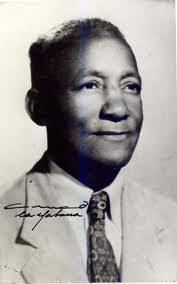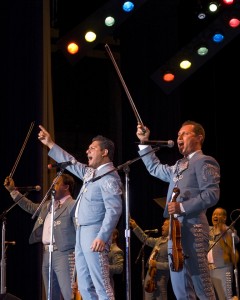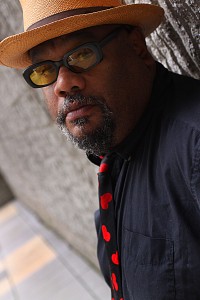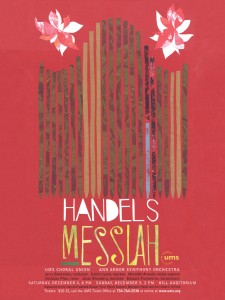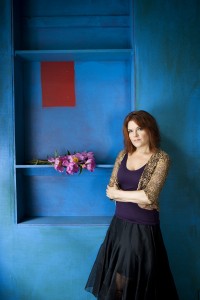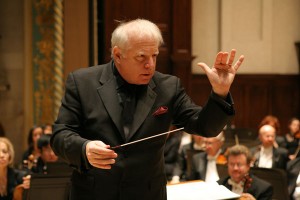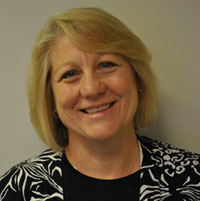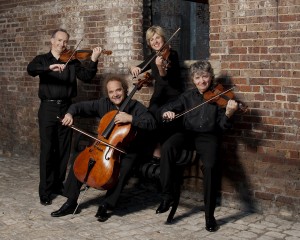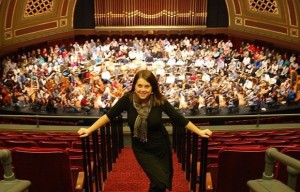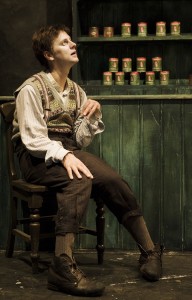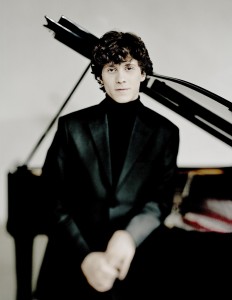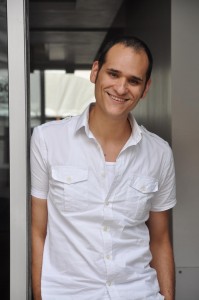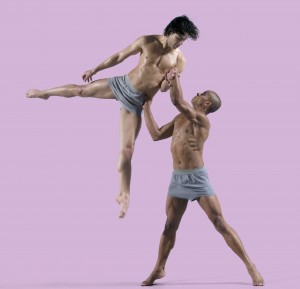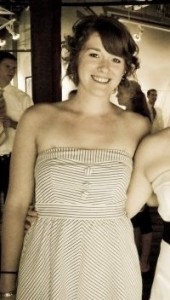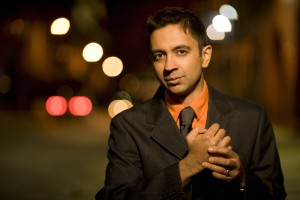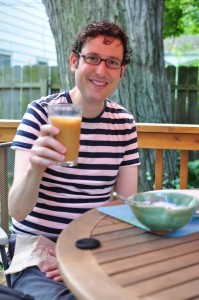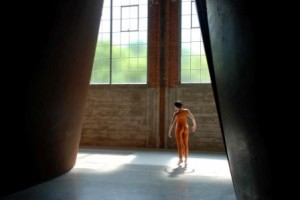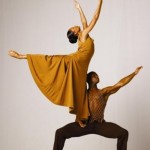Alberto Nacif on Septeto Nacional de Cuba
Of the many great Cuban musicians and orchestras to grace our stages, one that I thought I would never see is coming to Ann Arbor on Thursday, April 7th!
The Septeto Nacional de Cuba, which was founded in 1927 by Ignacio Pineiro (1888–1969), contrabass player, singer, and composer will perform the real Cuban son, the music of the Cuban countryside that took over dance halls and clubs alike in the early 1930s. This music, which is the true progenitor of Salsa and is still popular in both urban and rural settings, originated in Oriente, a province 600 miles from Havana and was a combination of African-derived instruments with Spanish verse forms and stringed instruments. The son has syncopated rhythms and catchy melodies and harmonies which make this a music to sing and dance to.
The music of Pineiro has become a part of the vocabulary of Cuban music, played lovingly by so many of the great musicians, past and present, Cuban and non-Cuban, and still fresh and vital 80 years later. The late 1920s were witness to an explosion of trios, quartets, sextets, and septets from different parts of Cuba each exploring the son, each competing for the pinnacle of expression. Pineiro named his septet “Septeto Nacional” because of the representation of musicians from all over Cuba, and quickly rose to be one of the most successful, thanks again to Pineiro’s compositions and the Septeto’s musicianship. It is no wonder then that so many young musicians are still drawn to this sublime style of music that has maintained its sepia-tone warmth along with Kodacolor excitement.
This concert will be this legendary and much-revered group’s first visit to Ann Arbor, a younger generation of young masters to bring the magic and fire of the Cuban son.
Don’t miss this!!!!
Our Favorite Moments from the Season
It’s hard to believe the first half of the 10/11 season has already come to a close. What an incredible first half it was though for all of us on the UMS Staff! We thought it would be fun to share some of our favorite moments from these past few months, and we invite you to leave a comment sharing your favorite moment too!
“Attending the Mariachi Vargas de Tecalitlán concert solo, I sat next to a wonderful Spanish-speaking grandmother who took me under her wing and translated each and every song: ‘this is a song about love.’ Two songs later: ‘this too, is a song about love.’ I loved the audience for that show as much as I loved the incredible music!” ~Truly Render, Press & Marketing Coordinator
“My husband and I were mesmerized by Robert McDuffie at the Venice Baroque Orchestra performance featuring the “American Four Seasons” work by Philip Glass. The electricity and energy from the stage, as well as the audience, made us feel we had experienced a once in a lifetime event. The icing on the cake was watching Philip Glass walk onto the stage to congratulate Robert McDuffie and join the group for the applause and well-deserved bows.” ~Kathy Brown, Executive Assistant
“Seeing the space at 523 S. Main Street transformed into a club-style performance venue for Stew & The Negro Problem.” ~Mark Jacobson, Programming Manager
“I am a great lover of Mahler’s music, so my favorite moment had to be hearing the Mariinsky Orchestra perform Mahler 5. It was the first time I had heard the piece performed live, and it was an extremely moving experience to say the least! I was so impressed by the musicality of Maestro Gergiev and the emotion he drew out of the Orchestra.” ~Stephanie Normann, Marketing Manager
“That’s a hard call for me. One moment that will not soon be forgotten occurred while I was working the box office at the Once Festival: the line of patrons waiting to purchase tickets intermixed with School of Music students holding mirrors (they were doing a performance art piece). Also, as a patron, I can’t decide between the whole Susurrus experience and that AMAZING kazoo playing by the Carolina Chocolate Drops. “ ~Suzie Davidson, Assistant Ticket Services Manager
“There was this wonderful moment during the Mariachi Vargas de Tecalitlán concert when one of the mariachis handed the microphone to an older man in the front row. The man began singing along into the microphone – he knew ALL of the words and he sounded fantastic! He was doing so well that the mariachis let him sing almost the entire song. It was thrilling to see such an amazing interaction between the artists onstage and an audience member – and to remind us that these musical traditions grow out of us and our everyday lives, and that, as audience members, we are crucial participants in the art we experience. That was such a joyful moment not only for that man, but for all of us gathered in Hill that night.” ~Jim Leija, Manager of New Media & Online Initiatives
“Stew and the Negro Problem at 523 S. Main was a real highlight of the fall for me. It was so exciting to see us enter a new space and transform it into a perfect setting for the concert experience. Those concerts felt so fresh!”
~Liz Stover, Programming Coordinator
“My favorite moments during this season so far were spent on the trails of the Matthaei Botanical Gardens installing the wayfinding signage for Susurrus. I’d never been there before, and it’s really a gorgeous place, especially in the fall. Lots of free oxygen! My most panic-stricken moment (these tend to become fond memories a little later down the line)? Getting Maestro Gergiev back to the airport in time to catch a flight following his appearance with the Mariinsky Orchestra. It was a nail biter!” ~Mary Roeder, Residency Coordinator
“Watching the Venice Baroque musicians serenade our interns backstage during intermission of the concert. They were all so gracious and made our interns experience that evening unique and special.”
~Anne Grove, Artist Services Manager
“The moment I still think about is Susurrus: it was so different from any other sort of theatrical experience I’ve had. I remember the story, but even more, I remember the feeling of the morning as a whole: the beautiful setting, the weather that day, the people who were walking around with me or were just touring the gardens, Dame Janet Baker singing ‘Dido’s Lament’… When I think back on Susurrus, I remember those feelings of calmness and contemplation, and it makes me want to feel that way again.” ~Lisa Murray, Manager of Foundation & Government Grants
Handel’s Messiah: 50 Years of Memories
As the Group Sales Coordinator at UMS, I speak with UMS concertgoers each year in late summer who are looking to book their group reservations as soon as possible. Without fail, several of these calls are for our annual presentation of Handel’s Messiah. As Delores Forsmark and I were speaking about her reservation this year, she shared with me that she and her husband have attended the Messiah performance for more than 50 years. I asked Delores if she would consider sharing some favorite experiences with us, and her husband Bert sent me a wonderful letter explaining how significant this holiday tradition has become for them.
Bert first heard the piece in its entirety after receiving the LP as a Christmas gift from his brother. Delores and Bert began attending the Messiah together in 1958, when Delores was a student at the University of Michigan. He and Delores have made the drive from Flushing, sometimes even in harsh winter snow and ice storms, almost each year since then. Bert writes, “Except for a few times when our kids were small, we have attended performances at Hill Auditorium (or the Michigan Theater, during the renovation) almost without exception, always with guests.”
Ever since that first interaction with the piece, the Forsmarks feel a special connection with the Messiah. Bert told me about how a painting he and Delores purchased, Dali’s Crucifixion, made him remember the lyrics “All we like sheep have gone astray: we have turned every one to his own way…”. Bert recalls, “That was in 1965, and as I sit here typing this, I still weep.”
Bert and Delores’ most memorable Messiah performance was in 1983. Having attended with 42 of their fellow church members and their pastor, Bert recalls how the soprano soloist that year brought a new significance to the performance. He still vividly remembers the passion she brought to the piece: “When she sang ‘Rejoice, rejoice, rejoice greatly’, her face glowed, and the audience rejoiced with her. She easily stole the show, and was the talk of the whole busload.” That soloist was Kathryn Bouleyn, also known as Kathryn Day, who previously performed in the Messiah at UMS in 1976, 1977, and 1978.
At UMS, we know that many of you share the Forsmarks’ appreciation for our annual production of the Messiah. Dr. Andrew Berry has also been attending for more than 50 years – he writes, “This is the beginning of my Christmas season every year. We always have a group, and we carpool to have dinner afterwards.” So what are your favorite memories? What is it about this performance that makes it so special for you? What are you most looking forward to when you walk into Hill Auditorium this year? We hope you’ll share your stories, and we look forward to starting up the holiday season with you this weekend.
It used to be that I found the repeated Amens at the conclusion to be tedious, but now I hear them as joyous Amens rolling through the heavens when the redeemed are gathered as the parts are sung, and at the conclusion sigh and say, ‘Only 364 days until the next one.’ -Bert Forsmark
Rosanne Cash – What’s on your List?
I’m not the biggest country fan in the world, but when I learned of Rosanne Cash’s upcoming UMS concert, The List, I was set on attending. When Rosanne Cash was 18 her father gave her a list entitled “100 Essential Country Songs.” This list of essential songs is the inspiration for Rosanne’s UMS performance. Even if you aren’t well acquainted with the music performed this Saturday, this concert is sure to be revealing. Rosanne Cash will perform songs that showcase the weight music holds in shaping a person’s identity, or in her case, her identity as an artist.
I’m always amazed at music’s ability to evoke memories and their associated emotions, like how I’m transported to the warm, simplistic summers of my childhood whenever I listen to Motown, or how I tear up with sympathy at every listening of “And I Am Telling You I’m Not Going.” I marvel at how we parallel our own experiences to themes expressed through music and are comforted by these associations. I love that these songs, their stories, remain embedded in my identity, accompanying me forever like a personal soundtrack of my life.
I can’t wait to see which songs Rosanne will choose to share with us on Saturday during The List. Her selections will certainly be memorable, partly as a tribute to her musical roots and partly as a narrative to her own unique history. I look forward to a glimpse of the world through her lyrical inspirations and perspective.
Inspired by The List performance, we at UMS want to know what’s on your list. I hope you will share your “essentials” with us! Don’t forget to include why these songs/pieces of music have made it on your list — feel free to include them in the comments below or to tweet them using the hash tag #umslobby. Who knows, maybe I’ll add them to mine.
See you Saturday at the show!
P.S. Be sure to check out The Local “Lists” Show on Thursday, September 23, at 9 pm at the Yellow Barn, 416 W Huron St, Ann Arbor, for an evening of local musicians performing songs from their lists of essential and influential music, inspired by Rosanne Cash’s The List concert.
UMS Staff Picks: Detroit Symphony Orchestra/Mahler’s Symphony No. 8 selected by Joanne Navarre, Manager of Annual Giving
SN: Mahler’s Symphony No. 8 (Symphony of a Thousand) is rarely performed due to the tremendous complement of musicians required of this work – what can audience members expect to see and hear when they attend this performance?
JN: They can expect to see and hear, first of all, excellent musicians. The “thousands” on the stage will include the Detroit Symphony, UMS Choral Union, U-M Chamber Choir, U-M University Choir, U-M Orpheus Singers, MSU Children’s Choir and the incomparable Leonard Slatkin leading the charge. The sheer mass of humanity will be impressive to see, and their music will be absolutely unforgettable.
SN: Have you ever seen another of Mahler’s Symphonies performed live? What about the performance(s) was the most memorable for you?
JN: Last season, I was fortunate to be in the audience when the San Francisco Symphony and Michael Tilson Thomas presented Mahler’s Symphony No. 2 (Resurrection), with the choral portion of the fourth movement being performed by the UMS Choral Union. Gustav Mahler believed that, “The symphony must be like the world. It must embrace everything.” In the Resurrection Symphony, he did exactly that; he embraced everything.
SN: What are you most looking forward to about experiencing Mahler 8 live?
JN: I am looking forward to experiencing the power and genius of Mahler’s music in the hands of Leonard Slatkin. This piece is Mahler’s magnum opus; in his words, “the greatest thing I have done.” For Mahler enthusiasts, this is the pinnacle.
SN: What other events are on your “must see” list for the 10/11 season?
JN: After Mahler 8, there are three things on my “must see” list: Susurrus (September 9-October 3, Matthaei Botanical Gardens); The Cripple of Inishmaan (Druid and Atlantic Theater Company), and Richard III and The Comedy of Errors (Propeller). I love theater.
JN: I am a sports fan. I like football and baseball, but I enjoy hockey most of all.
JN: Renée Fleming’s Handel arias, the Hilliard Ensemble’s Morimur, and Les Arts Florissants’ Charpentier album.
UMS Staff Picks: Takács Quartet selected by Liz Stover, Programming Coordinator
SN: The Takács Quartet has been treating UMS audiences to exceptional performances of chamber works for many years, but in the 10/11 season, there will be not one, but three very special opportunities to hear this quartet as they perform their Schubert Project cycle of concerts. What will be unique and memorable about each of these performances?
LS: It’s not every year that you get to hear so much of a single composer’s work in the span of a season, so I am thrilled for the opportunity to focus some attention on Schubert. While there’s not nearly enough time to hear all of his chamber music, we’ll hear some of my favorites: D.810 (“Death and the Maiden”), the “Trout” Piano Quintet, and the Cello Quintet! We’ve heard the Takács Quartet perform many times here in Ann Arbor (12, to be exact), but I’m also excited to hear them collaborate with other notable musicians: pianist Jeffrey Kahane (who is also music director of the Los Angeles Chamber Orchestra and Colorado Symphony), bassist John Feeney (principal bass of the Orchestra of St. Luke’s in New York), and cellist Paul Katz (who performed here three times as cellist of the Cleveland Quartet).
SN: Have you seen a performance by the Takács Quartet before?
LS: Yes. I saw them the last two times they were here, in March 2010 and April 2009, and I think in January 2007, too. I loved their April 2009 performance with Marc-André Hamelin when they performed the Schumann Piano Quintet. The first time I ever played chamber music for fun was with a piano quintet (though we played Brahms) so I really enjoy hearing that repertoire. It makes me think back to how challenging it was for me and how much I learned as a musician from playing in a small group rather than an orchestra.
SN: What are you most looking forward to about this series of performances?
LS: To begin with, I just love Schubert…his compositions can be so heartbreakingly romantic. Did you hear David Finckel, Wu Han, and Philip Setzer play the piano trios in February? There wasn’t a dull moment in that concert—it was a highlight of the season for me. As I mentioned before, it’s really exciting to hear so much of one composer’s work in one season, and this series of concerts lines up with a personal goal to build my knowledge of classical repertoire. I also share a love for chamber music (and Schubert) with my boyfriend Zack, who is a violist, so I’m looking forward to experiencing the concerts together.
SN: What other events are on your “must see” list for the 10/11 season?
LS: Mahler’s Fifth Symphony is one of the very reasons I work at UMS (hearing it performed by the New York Philharmonic in February 2005 made me instantly apply to become a UMS intern as a student) so I can’t wait to hear it again by the Mariinsky Orchestra. I’m also really excited about our collaboration with the Detroit Symphony Orchestra and Michigan Opera Theater to present Mahler’s Eighth Symphony. It’s a once-(or very few) in-a-lifetime opportunity to hear it performed and I’m excited to be involved in the production of that event. I’ve also become a huge dance lover over the past few years, so I’m looking forward to seeing all of the companies on our season—all are new to me! I also won’t miss Stew and the Negro Problem, Carolina Chocolate Drops, and Druid’s production of The Cripple of Inishmaan.
SN: What do you enjoy doing outside of work?
LS: Knitting! Almost two years ago, I began knitting seriously, and I have fallen in love with it! It’s a wonderful stress reliever and I just love the feeling of producing something. I’m currently working on a cardigan. I’ve even taught a few friends and coworkers to knit and it’s so exciting to see them producing beautiful garments. Besides that, I enjoy watching baseball (my boyfriend has turned me into a Red Sox fan), traveling, and spending time with friends and family (including my two dogs, Rumor and Gypsy, who live with my parents in the DC area). I’m also hoping to take my violin out soon and start playing more regularly as it’s been in my closet for the last year—I’m sure these concerts will inspire me to do so!
SN: What have you been listening to on your iPod?
LS: Since we presented Punch Brothers at the Power Center last summer, I have not been able to stop listening to them! Their CDs Punch and Antifogmatic are in very frequent rotation as well as some of their earlier work under Chris Thile’s name. I have also recently taken up spinning at the Y, and Lady Gaga helps me get through a solid hour of exercise. Other favorites include Broken Bells, Dave Matthews Band, Ingrid Michaelson, and Wilco. When it comes to classical music, Mahler and Rachmaninoff are two of my favorite composers, so this season’s repertoire is especially exciting for me!
UMS Announces Additions, Changes to 10/11 Season
The 10/11 UMS season opens one month from today with the site-specific theater work Susurrus at the Matthaei Botanical Gardens.
During our summer performance hiatus, we’ve been quite busy at UMS, closing out the 09/10 season and preparing for the 10/11 events. We’ve also been working to add some exciting events to the 10/11 lineup that came together too late for the initial announcement in April:
ASSI EL HELANI, Saturday, November 6 at 8 pm, Hill Auditorium. This Lebanese pop singer has been a major figure in the music scene of the Middle East since the 1990s, participating in numerous important musical events throughout Europe, the Arab World, and America. Also involved in humanitarian concerns, he is one of the true superstars to emerge from Lebanon. Tickets range from $10-$60 with a limited number of $150 VIP seats available.
NATIONAL THEATER LIVE, co-presentation of high-definition broadcasts with the Michigan Theater. Last season, UMS and the Michigan Theater joined forces to present high-definition broadcasts of three plays from the National Theater in London. The series was a big hit with audiences, and we’re delighted to announce an incredible line-up of six productions for the 10/11 season, which includes Complicite’s A Disappearing Number, which UMS brought to Ann Arbor two seasons ago. The titles include:
A Disappearing Number, directed by Simon McBurney in association with Complicite. Sunday, October 31, 2 pm.
Hamlet, directed by Sir Nicholas Hytner with Rory Kinnear in the title role. Sunday, January 2, 2 pm.
FELA! Directed by Bill T. Jones, direct from Broadway. The Tony Award-winning musical about the extravagant, decadent, and rebellious world of Afrobeat legend Fela Anikulapo Kuti explores his controversial life as an artist, political activist and revolutionary musician. Sunday, January 30, 2 pm.
King Lear, directed by Michael Grandage with Derek Jacobi in the title role, in association with the Donmar Warehouse and featuring the creative team behind the company’s recent Broadway hit about Mark Rothko, Red. Sunday, February 20, 7 pm.
Frankenstein, directed by Danny Boyle (Slumdog Millionaire, Trainspotting). Wednesday, April 6, 7 pm.
The Cherry Orchard, directed by Howard Davies and starring Zoë Wanamaker as Madame Ranevskaya. Sunday, July 17, 7 pm.
DATE CHANGES
Mariachi Vargas de Tecalitlán Date Change. To accommodate the addition of Assi El Helani, as well as youth performances for schoolchildren, the date of the public concert for Mariachi Vargas de Tecalitlán has been changed to Friday, November 5 at 8 pm – one day earlier than previously announced.
Kodo Date Change — FAMILY PERFORMANCE ONLY. The FAMILY PERFORMANCE of Kodo will take place on Thursday, February 24 at 11 am, not Wednesday, February 23 as published in the series brochure. The public performance of Kodo will still take place on Wednesday evening as previously announced.
Single ticket brochures will be mailed in about a week (don’t forget – the internet on-sale date is Monday, August 23, with phone and walk-up orders on Wednesday, August 25. Donors of $250+ may purchase beginning Wednesday, August 18!).
31 days to the start of the season…let the countdown begin!
UMS Arts Round-up: August 6
 Many members of the UMS staff keep a watchful eye on local and national media for news about artists on our season, pressing arts issues, and more. We thought we’d pull together a list of interesting stories each week and share them with you. Welcome to UMS’s Arts Round-up, a weekly collection of arts news, including national issues, artist updates, local shout-outs, and a link or two just for fun. If you come across something interesting in your own reading, please feel free to share!
Many members of the UMS staff keep a watchful eye on local and national media for news about artists on our season, pressing arts issues, and more. We thought we’d pull together a list of interesting stories each week and share them with you. Welcome to UMS’s Arts Round-up, a weekly collection of arts news, including national issues, artist updates, local shout-outs, and a link or two just for fun. If you come across something interesting in your own reading, please feel free to share!
National Issues
- In Seattle, dance class (modeled after Mark Morris’ Dance for PD) helps Parkinson’s patients
Artist Updates
- Alec Wilkinson of The New Yorker sits in on Wynton Marsalis’s latest project
- Politics as unusual? Wyclef Jean contemplates run for Haitian presidency
- A match made in heaven or a shotgun wedding? The Wall Street Journal discusses a possible merger between the Kennedy Center and the National Opera
- Boston Pops conductor Keith Lockhart takes the helm at the BBC Concert Orchestra
Local Shout-Outs
- Ann Arbor theater troupe Performance Network announces its 2010/11 season.
- Blackbird Theatre, another Ann Arbor theater company, spreads its wings with a move to the Kerrytown District
Just for Fun
“Flash Opera” at the Reading Terminal by the Philadelphia Opera Chorus!
UMS Staff Picks: The Cripple of Inishmaan selected by Sara Billmann, Director of Marketing & Communications
SN: The multi-award winning Druid and Atlantic Theater co-production of Martin McDonagh’s The Cripple of Inishmaan has been described as “a break-your-heart, cruelly funny evening” – what kind of theatrical journey can audience members expect to experience when they see this production?
SB: I don’t want to spoil the story, but suffice it to say that it will be quite an emotional ride.
I’ve seen two of Martin McDonagh’s plays when they were produced in New York in the mid-late 1990s, and they are simply brilliant pieces, in part because of the way they force you to re-examine your own morals. He sets up these outrageous scenes that are absolutely hilarious, then delivers the knock-out punch that makes you realize you’ve been laughing at something that is, in fact, incredibly tragic. The June issue of <i>Opera News</i> put it perfectly: “As anyone who’s ever sat through a Martin McDonagh play can attest, sometimes the only response we can muster when confronted with the searing emotional or physical pain of others is a laugh.”
I read this play poolside while visiting my in-laws in San Antonio and found myself laughing out loud on any number of occasions. Let’s face it, there are many plays where you chuckle inwardly, but something that produces a spontaneous outburst while reading to yourself is extraordinary in its own sense. And based on every production I’ve seen of McDonagh’s work, the live production will far exceed what’s on the page.
So that we could all familiarize ourselves with the play, about a dozen members of the UMS staff did a “read-through” this summer. I hope that some audience members will be interested in doing the same — we’d be interested in putting together play-reading groups for others and loaning the scripts. It’s a great way to familiarize yourself with the dialects and turns of language that really bring the piece alive. And, of course, a great way to meet new people too.
SN: What are you most looking forward to about this UMS debut performance?
SB: It’s pretty simple, really – I just can’t wait to see what they do with the production to bring it alive. I have friends who saw this production when it was on Broadway a few years ago and raved about it. Having grown up in a small town, I recognize some of the quirky characters and look forward to seeing how they are realized on stage.
SN: What other events are on your “must see” list for the 10/11 season?
SB: Just about everything! As a trained classical musician, I’m particularly interested in the big orchestras and piano recitals. I was turned on to Denis Matsuev about two years ago by someone who had heard his recording in Gramophone magazine. His playing is really quite extraordinary. I also adore Schubert and am looking forward to the three Tákacs concerts, as well as the Scharoun Ensemble performance of the Schubert Octet. I’m also looking forward to Grupo Corpo – what a great company! I could go on and on. The beauty of being the marketing director for UMS is that I start to research all of the artists we’re presenting long before we announce the season, and I always get turned on to things I never would have thought I’d enjoy…which ultimately means that the entire season becomes a “must see” for me.
SN: What do you enjoy doing outside of work?
SB: I have two kids – Elisabeth is 8 and going into 4th grade, and Harry is 6 and going into 1st grade – who keep me plenty busy. I was about to respond that I do laundry outside of work, until I saw the word “enjoy” in the question. Elisabeth loves to play baseball, so I think I’ve spent the better part of July attending her games and taking her to see the Tigers when time permits. I’m also hopelessly addicted to The New Yorker and steal moments here and there to try to stay caught up. Other hobbies include wine tasting and walking the dog – we acquired a boxer/pointer mix from the Humane Society three months ago, and I’ve become the family’s designated dog walker, which fills up a shocking amount of time each day.
SN: What have you been listening to on your iPod?
SB: Ha! The day I get to listen to my iPod will be a great day indeed. Lately my kids have been torturing me, making me listen to “Stayin’ Alive” and 1980s dance tunes (oh, to return to the days when my daughter would watch “The Barber of Seville” by choice…). But when I can wrestle it away from them, I mostly listen to Schubert lieder, Maria Joao Pires performing Schubert and Chopin, Denis Matsuev playing Rachmaninoff, and Mahler, though truth be told, the iPod doesn’t do Mahler justice. Murray Perahia‘s recital in 2000 of the Bach/Busoni Chorale Preludes and the Goldberg Variations will always rank among my top UMS performances, and I often bring back that memory with the recording “Songs Without Words” released around the same time. Angelika Kirchschlager and Fritz Wunderlich are among my favorite singers, though I will confess that I also enjoy Pink Martini in my less serious moments. And I recently loaded on a CD by a wonderful Iranian group called Ghazal.
UMS Staff Picks: pianist Rafal Blechacz selected by Susie Bozell Craig, Marketing and Corporate Partnerships Manager
SN: Although a relatively young artist, Rafal Blechacz has already established himself as a rising star in the international classical music community. How has he, at only 25 years of age, made his mark in that community and around the world?
SBC: Although he’d won several major piano competitions already, when one wins the Chopin Competition it comes with incredible opportunities. Winning the Gold Medal and all individual prizes in 2005 opened the door for him to perform at Tchaikovsky Hall in Moscow with the Mariinsky Orchestra and Valery Gergiev, at the Concertgebouw in Amsterdam, Wigmore Hall in London, and the Palais des Beaux Arts in Brussels among others. It also helped secure a five-year recording contract with Deutsche Grammophon which has so far resulted in three albums, including perhaps the best recording of Chopin’s Preludes I’ve ever come across.
SN: What “flavor” does he bring to his performance that distinguishes him as such an impressive talent?
SBC: What impresses me so much about Rafal is the incredibly musical maturity he possesses. In many ways, technical prowess is the easy part. But the ability to spin phrases with perfect balance and timing, to not take too many liberties while still drawing out poignancy, the achievement of an incredibly organic result…this takes true mastery. Artists can work for years and still not achieve this.
SN: What are you most looking forward to about his upcoming Ann Arbor performance?
SBC: Chopin is one of my favorite composers for the piano, and to hear a true artist perform his works, which are so romantic with their sense of longing, nostalgia, grief…I think it will be an incredibly emotional experience.
SN: What other events are on your “must see” list for the 10/11 season?
SBC: I’m looking forward to both of the Russian orchestras, the Mariinsky and St. Petersburg, with their blockbuster programs; also Susurrus as a totally unique and intimate experience; and the two Shakespeare plays with Propeller Theater Company, both of which are new to me.
SN: What do you enjoy doing outside of work?
SBC: I’m a pretty active tennis player, and I before I started working at UMS I made a living as a flutist and still enjoy practicing and teaching. My husband and I are also looking forward to the birth of our first child late this fall.
SN: What have you been listening to on your iPod?
SBC: Well, yesterday I listened to Rachmaninoff’s second and third piano concertos in preparation for the season. I’m headed over to Lake Michigan next weekend and that always brings out summertime favorites like Jack Johnson and a quirky folk band from northern Michigan called Third Coast. It’s got a pretty wide array of artists to suit the occasion and mood.
Which pianist featured on the 10/11 season are you most looking forward to hearing?
UMS Staff Picks: Laurie Anderson’s Delusion selected by Jim Leija, Public Relations Manager
SN: Laurie Anderson’s daring and thought-provoking use of technology in her pieces has earned her worldwide recognition – just what kind of an artist is she and how can audience members expect to see her multi-media approach come to life in Delusion?
JL: As a student and practitioner of performance art, I’ve studied and admired the legendary Laurie Anderson for a long time. Anderson is an artistic pioneer, blending visual imagery, text, and electronic music (even inventing several unique electronic instruments) to create theatrical events that twist our perception of reality. A lot of her text reminds me of that of the late monologist Spalding Gray (who was a collaborator of Anderson’s): slightly offbeat and neurotic, strangely funny, and astutely observant. When you’re watching Laurie Anderson perform, you almost feel like you’re in a dream – quirky, bizarre, trancelike, too real, or not real enough. Anderson has an incredible talent for taking bits and pieces of our hyper-commercial, hyper-politicized society and spinning them into moments of hyper-realistic cyber-techno poetry that challenge authority, bend reality, and demand that we see the world differently. Audiences can expect to be surprised and challenged by the way Anderson transforms herself through what she’s called “audio drag”: sometimes she’s the cool, calm, collected self-help guru, sometimes she’s the evil robot of our worst sci-fi futuristic nightmares, and other times she’s a domineering patriarch. Never one to mince words, Anderson has recently explored highly charged issues like homelessness, terrorism, the war in Iraq, the collapse of Wall Street, and the oil spill in the gulf. I am most excited by contemporary artists like Anderson who are willing to tackle tough issues in ways that might leave audiences feeling a little uncomfortable and a little uncertain about how they should respond. I like to feel challenged by performance and to be shaken out of everyday complacency. I expect that in Delusion we’ll experience many of the Laurie Anderson “ingredients” that I’ve mentioned, and we’ll be transported into Anderson’s unusual, but compelling universe.
SN: Have you seen a performance by Laurie Anderson before?
JL: I’ve actually never seen Laurie Anderson perform live! I’ve only experienced her work through video and audio recordings. I’m looking forward to finally seeing her perform in-the-flesh after admiring and studying her work for so long.
SN: What other events are on your “must see” list for the 10/11 season?
JL: When I was working on my MFA in Art & Design, I experimented with sound installation and the ways in which an artist can use sound to change how people experience a particular place. I’m looking forward to Susurrus to see how David Leddy uses sound and narrative to recreate the Matthaei Botanical Gardens in a new and exciting way. I just have a feeling that Susurrus is going to be really magical.
Carolina Chocolate Drops is an absolute must. I saw the group when they first played at The Ark three years ago, and I still think back to that concert as one of the best I’ve seen in recent years. The CCD is so masterful at blending amazing bluegrass musicianship with educational tidbits about Black string music. I learned a lot, and I slapped my knee to the beat a lot, and I plan to do the same when they take the stage at the Michigan Theater.
SN: What do you enjoy doing outside of work?
JL: For me, the summer is all about vegetable gardening, going to the Ann Arbor Farmer’s Market, and cooking up a storm. I grow everything from tomatoes to eggplant to kale and herbs in my backyard garden, and my partner and I get a farm share from Tantre Farm in Chelsea. We love to see just how “local” we can be, especially during the summer months when so much amazing, fresh food is available in Ann Arbor.
SN: What have you been listening to on your iPod?
JL: The performance artist in me is listening to a lot of Lady Gaga. The chef in me is catching up on Splendid Table podcasts. The hipster in me is jamming to OK Go (can you believe that video with the Rube Goldberg machine?!).
Have you seen a live performance by Laurie Anderson before? We’d love to hear about your favorite performance artist!
UMS Staff Picks: Grupo Corpo selected by Rachelle Lesko, Development Administrative Assistant
SN: Grupo Corpo’s work has been described as “searing sensuality elegantly under control” (Le Monde, Paris)—what specific style(s) of dance can audience members expect to see at this performance?
RL: From the numerous video clips I have seen, they are masters of blending many different styles of dance like ballet, modern dance, and Brazilian dance. Each of these dance styles is known for different focal elements such as grace, fluidity, dynamic energy, and sensuality, and the way that Grupo Corpo manages to merge and transition between these different stylistic elements is incredible. The piece Imã, which they are performing in Ann Arbor, showcases a tremendous sense of fluidity and strength between the dancers. Throughout the course of the piece they seamlessly transition from modern dance and Afro-Brazilian visual and musical influences to lyrical ballet and lively, hip-shaking samba moves. I can’t wait to see it in its entirety.
SN: Have you seen a performance by Grupo Corpo before?
RL: I have not seen Grupo Corpo perform in person before, but I have attended many other UMS dance performances. A few that I particularly enjoyed over the years were Rubberbandance Group, Hubbard Street Dance Chicago, and the Trinity Irish Dancers — each of which embodies, in different ways, the energy, athleticism, and passion that can be found in Grupo Corpo. I love attending dance performances because of the sheer emotion and physicality present on the stage in front of you, which I find thrilling. I never get bored! There is always something to capture my attention, whether it’s the amazing technique of an individual or the interactions and broader picture of the group as a whole. I find dance companies that make a point to interweave different dance styles, like Grupo Corpo, especially enjoyable to watch because they throw in a little bit of the familiar for everyone, but then take you by surprise and bring it to a completely new and creative level.
SN: What are you most looking forward to about this performance?
RL: I think I am most looking forward to experiencing the blend of their particular dance styles, especially the incorporation of Brazilian samba and Afro-Brazilian roots. Latin dance (and music) is incredibly dynamic, infectious, and just plain fun! I can’t wait to see how Grupo Corpo brings that flavor to life on the stage AND to the audience.
SN: What other events are on your “must see” list for the 10/11 season?
RL: Wow. That’s a hard question! First of all, I want to say that I’m really excited about this season in general because there are so many artists coming that I personally am not familiar with and/or have never seen perform before, so I’m really looking forward to a year of new experiences. However, I do have a few that are definitely on my radar, like Rosanne Cash, Carolina Chocolate Drops, Rafal Blechacz, Tetzlaff Quartet, Mariachi Vargas de Tecalitlán… I’ll stop there, but I could go on! I think this season’s global focus on the Americas is going to be very exciting and I’m looking forward to attending many of those concerts.
SN: What do you enjoy doing outside of work?
RL: In my free time I enjoy playing the trumpet, both casually and in a local concert band, and spending time with friends and family. I also enjoy running and have recently started to participate in longer distance road races, which I find much more fun and exciting than the training part!
SN: What have you been listening to on your iPod?
RL: Well, a lot of what I’ve been listening to lately has been my running music so it’s a lot of upbeat 80’s rock music: Def Leppard, AC/DC, Journey, R.E.M, Madonna, etc., as well as some Natalie Merchant, Tori Amos, and Norah Jones to relax.
What is the most memorable dance event you’ve ever been to?
UMS Staff Picks: Vijay Iyer Trio and Rudresh Mahanthappa’s Apex selected by Mark Jacobson, Programming Manager
SN: This concert features a double bill of two jazz combos: the Vijay Iyer Trio and Rudresh Mahanthappa’s Apex. What can audience members expect to hear from these two ensembles? In what ways are they similar and different to each other?
MJ: Great question, as I believe that one of the essential hallmarks that distinguishes the success of any double-bill concert concerns the relationship—musical or otherwise—between the two ensembles or artists being presented. Vijay and Rudresh have shared a significant and meaningful musical journey together over the last decade and have undoubtedly influenced each other’s body of work. They have proven to be two of the most prolific artists of the new millennium distilled from the tremendous New York City improvising community, each simultaneously leading and writing for multiple ensembles that explore their varying individual interests and intellectual pursuits, including fusing South Asian musical forms and harmony with Western jazz traditions, to genre-defying, multimedia and spoken-word projects that explore issues of ethnicity and cultural identity.
Vijay’s long-standing trio has truly developed an original “sound,” mixing angular rhythms and challenging harmonies within an historical study and deep respect of popular and improvised music. Vijay’s ensemble has recently tackled musical “covers” of composers as diverse as Leonard Bernstein, visionary Andrew Hill, and pop sensation M.I.A.! Somehow, Vijay, Stephan, and Marcus have a collective ability to make this otherwise complex music accessible and enjoyable, and have been hitting on all strides.
Rudresh and Bunky Green’s co-led Apex is a brand-new quintet that only recently had its NYC debut this spring. Because of this, I haven’t yet had the opportunity to hear this band live, so we will need to wait to hear how Rudresh and Bunky’s approach will differ from that of Vijay’s trio! Using Apex as a vehicle to finally call public attention and due respect to septuagenarian jazz pedagogue Bunky’s contributions to the art form, I’m anticipating on-stage fireworks between the two alto saxophonists fueled by young Damion Reid, one of today’s most exciting New York drummers.
There is certainly a lot more to come from Rudresh and from Vijay, as both artists are still under the age of 40!
SN: Have you heard either of these combos, or members of them, perform live before?
MJ: I met Vijay and spent time with him when he was a guest of the Doris Duke Charitable Foundation and the NEA’s Jazz Initiative Annual Meeting of JazzNet partners in the summer of 2005 at the North Sea Jazz Festival in The Hague. Vijay is a musician that is equally comfortable communicating his artistic initiatives via both his live performances as well as through non-musical, verbal communication. The artistic goals of the trio are well-conceived and each member is whole-heartedly committed to the ensemble’s overall sound and style. Marcus Gilmore, who has been Vijay’s “first-call” drummer for a number of years, is actually legendary drummer Roy Haynes’ grandson! Marcus is not only one of the most skilled technicians on the drum kit, but his energy, fire, and natural “feel” make him someone to definitely watch…and hear.
SN: What are you most looking forward to about this performance?
MJ: As this concert will be presented in collaboration with the 2011 University of Michigan Jazz Combo Festival, I’m excited that so many young high school music students will have the opportunity to be exposed to “top-shelf” live improvisation. Great artists simultaneously assume tremendous responsibility and have the pleasure of being deeply influential to developing musicians—especially within the context of the jazz tradition.
SN: What other events are on your “must see” list for the 10/11 season?
MJ: My short list includes our UMS centennial celebration of gypsy guitarist Django Reinhardt by the Hot Clubs of Detroit and San Francisco ; Tony Award-winning songwriter and lyricist Stew’s band The Negro Problem, co-led with his partner Heidi Rodewald; the final opportunity to see the iconoclastic work of the Merce Cunningham Dance Company in Ann Arbor; and Fela Anikulapo Kuti collaborator and pioneer Tony Allen’s Afrobeat Tour direct from the man who “put the beat in Afrobeat” in April.
SN: What do you enjoy doing outside of work?
MJ: My wife and I had fraternal twins this past October (a girl and a boy!), so much of my time away from UMS is gladly being spent with them! Having children has, of course, opened my mind in so many wondrous ways. I have also managed to build a modest record collection (so much music is still only available on out-of-print LPs); I get a disproportionate amount of pleasure from discovering and listening to hard-to-find records or, for that matter, any music that is new to me.
SN: What have you been listening to on your iPod?
MJ: On heavier rotation recently has been a spring release on Warp Records by L.A.-based electronic artist Flying Lotus (born Steven Ellison) who is actually the late Alice Coltrane’s nephew! (I’ll forever remember working with Alice in one of her final concerts in September 2006 at Hill Auditorium….) I’ve also been enjoying Toronto-based Broken Social Scene’s ambitious Forgiveness Rock Record released on their own Arts & Crafts label. In the realm of improvisational music, I’ve been wowed by New York City-based alto saxophonist and composer Steve Lehman’s exploration (and realization!) of a “spectral harmonic” approach to ensemble writing and solo improvisation featured on Travail, Transformation, and Flow (Pi Recordings) by the Steve Lehman Octet. Truly astonishing. I’ve also been enjoying vocalist José James’ album with pianist/collaborator Jef Neve. In the world of large-scale, orchestral composition, I’ve been attempting to re-create the live experience of attending a semi-staged concert of composer Osvaldo Golijov’s magnum opus, La Pasión según San Marcos (The Passion according to St. Mark), at Lincoln Center’s Mostly Mozart Festival a couple of summers ago via a new recording of the work released on Deutsche Grammophon.
We’d love to hear which jazz event you’re most looking forward to on the 10/11 season!
UMS 10/11 Season: The Complete List
We realize not everyone wants the multimedia bells n’ whistles when it comes to getting information about the new UMS season. That’s why we’ve created a link (back on www.ums.org) where you can download a simple listing of the entire 10/11 UMS season.
Click here for a complete chronological listing of the 10/11 season. [pdf]
Download or view the 10/11 Season Brochure.
Subscription renewal packets will be mailed to current subscribers in early May. On Monday, May 10, subscription sales will open to the general public. Subscriptions may be purchased using a paper order form or through the UMS website. Subscriber benefits include installment billing, free exchanges, free parking to subscribers of at least eight events, priority access to special non-series concerts, and the opportunity to discuss programming in depth with members of the UMS Programming Committee to facilitate decision-making.
Tickets to individual events will go on sale to the general public on Monday, August 23 (via www.ums.org) and Wednesday, August 25 (in person and by phone).
To be added to the mailing list, please contact the UMS Ticket Office at 734-764-2538 or visit www.ums.org. UMS also has an e-mail list that provides up-to-date information about all UMS events; sign-up information is available on the website.
For series information with multimedia links and in-depth information:
20th Annual Dance Series Announced
The University Musical Society is pleased to announce its 20th Annual Dance Series, with five companies performing in the Power Center and the Detroit Opera House. The series includes:
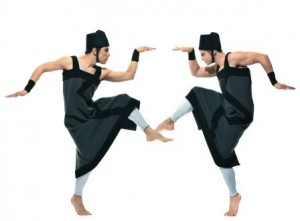 Paul Taylor Dance Company
Paul Taylor Dance Company
Paul Taylor, artistic director
Thursday, October 7 | 8 pm
Friday, October 8 | 8 pm
Saturday, October 9 | 8 pm
Power Center
More than a half-century ago, after performing in the companies of Merce Cunningham, Martha Graham, and George Balanchine, Paul Taylor became the youngest member of the pantheon that created American modern dance. Now approaching 80 — an age when most artists’ best work is behind them — Taylor is acclaimed for the vibrancy, relevance, and power of his dances. As prolific as ever, he continues to offer cogent observations on life’s complexities while tackling some of society’s thorniest issues. While his work has largely been iconoclastic, since the very start of his career Taylor has also made some of the most purely romantic, most astonishingly athletic, and downright funniest dances ever put on a stage. UMS, in collaboration with the U-M Department of Dance, shines a light on Paul Taylor, with a day-long residency and three performances highlighting just a fraction of the more than 130 dances he has created. “What other artist today makes poetic drama of such variety and eloquence? A Taylor season is a journey through one of the most singular and searching imaginations of our time.” (The New York Times, 2/17/10)
Program (Thurs 10/7)
Speaking in Tongues (Music by Matthew Patton) (1988)
Esplanade (J.S. Bach) (1975)
Program (Fri 10/8)
Orbs (Ludwig van Beethoven) (1966)
Also Playing (Gaetano Donizetti) (2009)
Program (Sat 10/9)
Black Tuesday (Songs of the Great Depression) (2001)
The Word (David Israel) (1998)
Piazzolla Caldera (Astor Piazzolla and Jerzy Peterburshsky) (1997)
Sankai Juku: Hibiki
Ushio Amagatsu, director, choreographer, and designer
Saturday, October 23 | 8 pm
Sunday, October 24 | 2 pm
Power Center
Ushio Amagatsu, the founder and artistic director of Sankai Juku, trained in classical as well as modern dance before he devoted his life to butoh. Butoh first appeared in Japan after World War II and is often defined by its playful and grotesque imagery, taboo topics, and absurd environments. Traditionally performed in white body makeup with slow, hyper-controlled, mesmerizing motion, butoh represents to Amagatsu a “dialogue with gravity,” whereas most dance forms revel in the escape from gravity. It plays with the perception of time and space through slowing down the experience — the dance equivalent of haiku, only much longer. The company last appeared in Ann Arbor in 1999. In 2002, the work that they will perform, Hibiki – Resonance From Far Away, received an Olivier Award for “Best New Dance Production.” “[Ushio Amagatsu] conveys the infinitely minute yet spellbinding transformations of a world in constant metamorphosis.” (Dance Magazine)
Grupo Corpo
Rodrigo and Paulo Pederneiras, artistic director and choreographer
Friday, January 21 | 8 pm
Saturday, January 22 | 8 pm
Power Center
This electrifying Brazilian dance company captivates with stunning, sexy physicality, dynamic ability, and rich visual flair. Grupo Corpo (literally “Body Group”) creates a vibrant and seamless blend of ballet’s grace, modern dance’s verve, and the hip-swiveling exuberance of Carnival sambas and their Afro-Brazilian roots. Founded in 1975, Grupo Corpo returns to Ann Arbor — the company appeared in 2002 as part of UMS’s focus on Brazilian artists — with two performances featuring Ímã (2009) and another work to be announced. Don’t miss this chance to experience Grupo Corpo’s “searing sensuality elegantly under control.” (Le Monde, Paris)
Merce Cunningham Dance Company
Friday, February 18 | 8 pm
Saturday, February 19 | 8 pm
Power Center
When the always forward-thinking Merce Cunningham passed away in July 2009 at the age of 90, he left behind a plan for the dissolution of his dance company and the preservation of his works: a two-year legacy tour that would end on December 31, 2011 with a performance in New York City. Cunningham was undeniably a leader of the American avant-garde throughout his 70-year career and is considered one of the most important choreographers of our time. Through much of his life, he was also one of the greatest American dancers, performing with the Martha Dance Company for six years. With an artistic career distinguished by constant innovation, Cunningham expanded the frontiers of dance, but also of contemporary visual and performing arts. His collaborations with artistic innovators from every creative discipline have yielded an unparalleled body of American dance, music, and visual art. These two different programs will be drawn from the more than 150 dances that Cunningham created over more than six decades of choreographic innovation. In Merce’s own words: “You have to love dancing to stick to it. It gives you nothing back, no manuscripts to store away, no paintings to show on walls and maybe hang in museums, no poems to be printed and sold, nothing but that single fleeting moment when you feel alive.” Fleeting for the dancer, perhaps, but creating lasting impressions for the audiences that experience it.
Alvin Ailey American Dance Theater
Judith Jamison, artistic director
Thursday, March 3 | 7:30 pm [note start time!]
Detroit Opera House
UMS is partnering with the Detroit Opera House so that UMS dance subscribers can experience this quintessentially American dance company. The Alvin Ailey American Dance Theater grew from the now-fabled performance in March 1958 at the 92nd Street Young Men’s Hebrew Association in New York. Led by Alvin Ailey and group of young African-American modern dancers, that performance forever changed the perception of American dance. Now, some 52 years later, the company has performed for an estimated 23 million people in 48 states and 71 countries on six continents. The company has earned a reputation as one of the most acclaimed international ambassadors of American culture, promoting the uniqueness of the African-American cultural experience and the preservation and enrichment of the American modern dance heritage. When Alvin Ailey began creating dance, he drew upon his “blood memories” of Texas, the blues, spirituals, and gospel as inspiration, which resulted in the creation of his most popular and critically-acclaimed work, Revelations.
This performance is only available to dance subscribers; all other tickets will be sold through the Detroit Opera House. UMS will offer round-trip luxury coach service to Detroit for this performance for those who prefer not to drive (details to be announced).
Tickets for the five-performance series range from $133-$206. Subscription renewal packets and brochures will be mailed in early May.
Tickets to individual events on the series go on sale on Monday, August 23 (via www.ums.org) and Wednesday, August 25 (in person and by phone).
Which events in the season are you most anticipating? What are memorable dance performances of years past? Let us know in the comments area.
UMS Announces 10/11 Choral Union Series & Piano Series
The University Musical Society is pleased to announce its 132nd Annual Choral Union Series, with 10 concerts in Hill Auditorium. The series includes:
Mariinsky Orchestra
Valery Gergiev, conductor
Denis Matsuev, piano
Sunday, October 10 | 4 pm
Hill Auditorium
Gergiev’s long association with the Mariinsky Theatre — including 10 UMS appearances, most recently the five-concert cycle of Shostakovich symphonies —has raised the ensemble’s profile to the point where it is now widely regarded one of the most dynamic and exciting ensembles on the world stage today. The fiery Russian pianist Denis Matsuev has received worldwide acclaim for his rare combination of technical virtuosity and deep musicality since his stunning victory at the 11th International Tchaikovsky Competition in Moscow in 1998. “His technique is phenomenal: blistering passagework, steely chords. Perhaps he is the new Horowitz.” (London Times)
Program
Rachmaninoff Piano Concerto No. 3 in d minor, Op. 30
Mahler Symphony No. 5
Venice Baroque Orchestra
Robert McDuffie, violin
Wednesday, October 27 | 8 pm
Hill Auditorium
The Venice Baroque Orchestra was founded in 1997 by harpsichordist Andrea Marcon and is recognized as one of Europe’s premier ensembles devoted to period instrument performance. For this UMS debut, they perform music of their home city — Venetian composer Antonio Vivaldi’s The Four Seasons — paired with an “American Four Seasons” by Philip Glass featuring violinist Robert McDuffie, who has worked closely with Glass over the years and who made his UMS debut with the Jerusalem Symphony in 2008.
Program
Vivaldi The Four Seasons, Op. 8 (1723)
Glass Violin Concerto No. 2: “The American Four Seasons”
Murray Perahia, piano
Wednesday, November 10 | 8 pm
Hill Auditorium
Anyone who has heard one of Murray’s Perahia’s previous 11 UMS appearances would have to agree with the assessment of The Los Angeles Times: “Perahia is a marvel.” In the more than 35 years he has been performing on the concert stage, he has become one of the most cherished pianists of our time. “Perahia may be the closest thing to a pure conduit of music — one in which the imagination and skill of the player are entirely at the service of the composer, not the player’s ego…The soul of a poet, the mind of a thinker, the hands of a virtuoso: No wonder audiences love this guy.” (The Seattle Times)
Program to be announced.
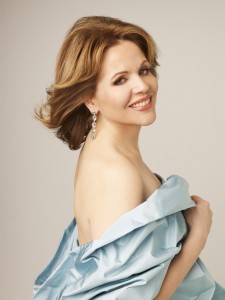 Renée Fleming, soprano
Renée Fleming, soprano
Sunday, January 16 | 4 pm
Hill Auditorium
One of the most beloved and celebrated musical ambassadors of our time, soprano Renée Fleming captivates audiences with her sumptuous voice, consummate artistry, and compelling stage presence. In addition to commanding the stages of the great opera houses of the world, she hosts the Metropolitan Opera’s Live in HD Series for movie theaters and television with behind-the-scenes interviews. Her fame is such that perfumes, desserts, and flowers have all been named after her, but those superficial accolades pale in comparison to her devoted following of opera lovers around the world. This great American soprano returns to UMS after her 1997 recital and her 2005 appearance in a concert version of Richard Strauss’s Daphne.
The Cleveland Orchestra
Franz Welser-Möst, conductor
Pierre-Laurent Aimard, piano
Tuesday, February 1 | 8 pm
Hill Auditorium
Founded shortly after the end of World War I, the Cleveland Orchestra has been guided by seven music directors, each of whom has left his mark on the widely admired “Cleveland” sound: Nikolai Sokoloff, Artur Rodzinski, Erich Leinsdorf, George Szell, Lorin Maazel, Christoph von Dohnányi, and Franz Welser-Möst, who leads the ensemble and the French pianist Pierre-Laurent Aimard in this performance.
Program
Bartók Music for Strings, Percussion, and Celeste, Sz. 106, BB 114
Schumann Piano Concerto in a minor, Op. 54
Wagner Overture to Tannhäuser
Rafał Blechacz, piano
Friday, February 11 | 8 pm
Hill Auditorium
In October 2005, the 20-year-old Rafał Blechacz, an unassuming young man from a small town in northern Poland, arrived in Warsaw for the 15th International Chopin Competition. His sensational performance won not only the competition, but also all four special prizes for the polonaise, mazurka, sonata, and concerto performance — in fact, one of the judges remarked that he “so outclassed the remaining finalists that no second prize could actually be awarded.” Blechacz was the first Pole to win the prize since Krystian Zimerman 30 years earlier. Notwithstanding his young age, his playing offers poetry, maturity, poise and concentration, as well as a phenomenal and luminous technique. “How reassuring it is to see one so young putting poetry first…we were all on another planet.” (Financial Times)
Program to be announced.
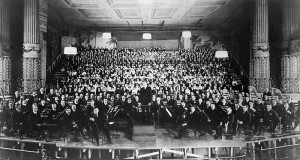 Mahler’s Symphony No. 8
Mahler’s Symphony No. 8
Detroit Symphony Orchestra
UMS Choral Union
U-M Chamber Choir
U-M University Choir
U-M Orpheus Singers
MSU Children’s Choir
Leonard Slatkin, conductor
Saturday, March 19 | 8 pm
Hill Auditorium
In commemoration of the 150th anniversary of Gustav Mahler’s birth and the 100th anniversary of his death, UMS is collaborating with the DSO and Michigan Opera Theatre to present a spectacular, not-to-be-missed performance of Mahler’s monumental Symphony No. 8, also known as “Symphony of a Thousand.” The first performance of this “choral symphony” featured a chorus of about 850, with an orchestra of 171, leading Mahler’s agent to dub to the work “Symphony of a Thousand.” While Mahler himself did not approve of the title, it nevertheless remains associated with this work, which is rarely preformed due to the massive forces required to do it justice.
Bach’s Mass in b minor
Bach Collegium Japan
Masaaki Suzuki, conductor
Thursday, March 24 | 8 pm
Hill Auditorium
Founded in 1990 by Masaaki Suzuki with the aim of introducing Japanese audiences to period instrument performance of great works of the Baroque period, the Bach Collegium Japan comprises both orchestra and chorus. The group has developed a formidable reputation through its recordings of J.S. Bach’s church cantatas, and returns to Ann Arbor after its 2003 St. Matthew Passion in St. Francis of Assisi Catholic Church. Widely regarded as one of the supreme achievements in classical music, the Mass in b minor was composed over a period of 25 years and assembled in its present form in 1749, the year before Bach died. “I have never heard period instruments played with such purity of tone, so reliably in tune. The small, precise, dramatically alert chorus breathed fire but also revealed a heartbreaking tenderness.” (The Los Angeles Times)
St. Petersburg Philharmonic
Yuri Temirkanov, conductor
Nikolai Lugansky, piano
Saturday, April 2 | 8 pm
Hill Auditorium
The Russian city of St. Petersburg boasts two world-class orchestras, and UMS has enjoyed a long relationship with each. The St. Petersburg Philharmonic has appeared in Ann Arbor five times under Yuri Temirkanov’s leadership. With a history dating back more than 200 years, the St. Petersburg Philharmonic is embedded with musical history, performing the world premiere of Beethoven’s Missa Solemnis in 1824, as well as Tchaikovsky’s Symphony No. 6, Prokofiev’s Symphony No. 1, and many works by Shostakovich. Pianist Nikolai Lugansky, who won the 1994 Tchaikovsky Piano Competition, makes his UMS debut. A Russian newspaper said of his performance in the final round of competition: “It was like getting sunstroke, a musical shock. Nobody could imagine that the soul of this unpretentious, modest young man, with his ascetic, but also poetic appearance, held such a volcano inside with inspired and resolute control.”
Program
Rimsky-Korsakov Scheherazade, Op. 35
Rachmaninoff Piano Concerto No. 2 in c minor, Op. 18
Liebeslieder Waltzes
Genia Kühmeier, soprano
Bernarda Fink, mezzo-soprano
Michael Schade, tenor
Thomas Quasthoff, bass-baritone
Malcolm Martineau, piano
Justus Zeyen, piano
Saturday, April 23 | 8 pm
Hill Auditorium
After nearly a decade in which he composed no vocal music at all, Schumann made a striking return to the genre with the Spanisches Liebeslieder song collection, which combines songs for solo voice with duets and quartets. A generation later, Brahms took the same instrumentation — vocal quartet plus four-hand piano —and composed the Liebeslieder and Neue Liebeslieder Waltzes. These three works serve the centerpiece of a program that also includes Brahms’ composition for vocal quartet and piano, performed by a brilliant quartet of musicians, including bass-baritone Thomas Quasthoff, who last appeared at UMS in a Lydia Mendessohn Theatre recital in 2000.
Program
Schumann Spanische Liebeslieder, Op. 138
Brahms Liebeslieder Waltzes, Op. 52
Brahms Four Songs from Quartets for Four Voices and Pianos, Ops. 64 & 92
Brahms Neue Liebeslieder Waltzes, Op. 65
Tickets for the 10-concert series range from $100-$650. Subscription renewal packets and brochures will be mailed in early May.
In addition to the 10-concert Choral Union Series, five events listed above will be packaged as a Piano Series (Kirov Orchestra with Denis Matsuev, Murray Perahia, Cleveland Orchestra with Pierre-Laurent Aimard, Rafał Blechacz, and St. Petersburg Philharmonic with Nikolai Lugansky). Prices for the five-concert Piano Series range from $50-$310.
Tickets to individual events on the series go on sale on Monday, August 23 (via www.ums.org) and Wednesday, August 25 (in person and by phone).


